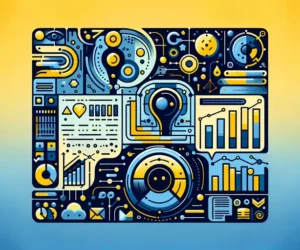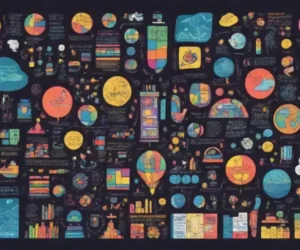
Can Machine Learning Unlock the Secrets of Quantum Theory?

Machine Learning and Quantum Theory
The intersection of Machine Learning (ML) and Quantum Theory is a burgeoning field that promises to revolutionize our understanding of the quantum world. Machine learning, a subset of artificial intelligence, uses algorithms to identify patterns and make predictions based on data. Quantum theory, on the other hand, is the branch of physics that deals with phenomena at atomic and subatomic levels. Combining these two fields could unlock new insights into the mysteries of the quantum realm.
What is Machine Learning?
Machine learning is a method of data analysis that automates analytical model building. It is based on the idea that systems can learn from data, identify patterns, and make decisions with minimal human intervention. Supervised learning, unsupervised learning, and reinforcement learning are the main types of machine learning.
Understanding Quantum Theory
Quantum theory is a fundamental theory in physics that describes the physical properties of nature at the scale of atoms and subatomic particles. It explains phenomena that classical physics cannot, such as superposition, entanglement, and quantum tunneling. Quantum mechanics has led to the development of various technologies, including quantum computers and quantum cryptography.
Example: Basic Machine Learning Model in Python
Here’s an example of a basic machine learning model using Python and the scikit-learn library:
from sklearn.datasets import load_iris
from sklearn.model_selection import train_test_split
from sklearn.ensemble import RandomForestClassifier
from sklearn.metrics import accuracy_score
# Load dataset
iris = load_iris()
X = iris.data
y = iris.target
# Split data into training and testing sets
X_train, X_test, y_train, y_test = train_test_split(X, y, test_size=0.2, random_state=42)
# Train model
model = RandomForestClassifier(n_estimators=100, random_state=42)
model.fit(X_train, y_train)
# Predict and evaluate
y_pred = model.predict(X_test)
accuracy = accuracy_score(y_test, y_pred)
print(f'Accuracy: {accuracy}')The Potential of Machine Learning in Quantum Theory
Enhancing Quantum Computing
Quantum computing leverages the principles of quantum mechanics to perform computations at speeds unimaginable with classical computers. Machine learning algorithms can optimize quantum circuits, improve error correction, and develop new quantum algorithms, making quantum computers more powerful and efficient.
Quantum Machine Learning
Quantum machine learning (QML) is an interdisciplinary area combining quantum physics and machine learning. QML algorithms, such as Quantum Support Vector Machines (QSVM) and Quantum Neural Networks (QNN), aim to solve problems faster than their classical counterparts. QML can also enhance classical machine learning models by leveraging quantum computational advantages.
Example: Quantum Machine Learning with Qiskit
Here’s an example of implementing a basic quantum machine learning algorithm using IBM’s Qiskit:
from qiskit import Aer, QuantumCircuit, transpile
from qiskit.utils import QuantumInstance
from qiskit.algorithms import VQC
from qiskit_machine_learning.algorithms import QSVC
from qiskit_machine_learning.kernels import QuantumKernel
# Define quantum circuit
qc = QuantumCircuit(2)
qc.h(0)
qc.cx(0, 1)
# Define quantum kernel
quantum_instance = QuantumInstance(backend=Aer.get_backend('qasm_simulator'))
kernel = QuantumKernel(feature_map=qc, quantum_instance=quantum_instance)
# Define quantum support vector classifier
qsvc = QSVC(quantum_kernel=kernel)
# Train and evaluate QSVC
# (Assume X_train, y_train, X_test, y_test are predefined datasets)
qsvc.fit(X_train, y_train)
accuracy = qsvc.score(X_test, y_test)
print(f'Accuracy: {accuracy}')Applications of Machine Learning in Quantum Theory
Discovering New Quantum Materials
Machine learning can assist in discovering new quantum materials by analyzing large datasets of material properties and predicting which combinations of elements will exhibit desired quantum behaviors. This approach accelerates the discovery process, enabling the development of new materials for quantum computing, superconductors, and topological insulators.
Quantum Error Correction
Quantum error correction is vital for maintaining the integrity of quantum information. Machine learning algorithms can optimize error correction codes and protocols, improving the fidelity of quantum computations. Techniques like reinforcement learning are particularly effective in learning optimal strategies for error correction.
Example: Quantum Material Discovery with Machine Learning
Here’s an example of using machine learning for quantum material discovery:
import numpy as np
from sklearn.ensemble import GradientBoostingRegressor
# Simulated dataset of material properties
X = np.random.rand(1000, 10) # Feature vectors representing material compositions
y = np.random.rand(1000) # Target values representing desired quantum properties
# Train gradient boosting model
model = GradientBoostingRegressor(n_estimators=100)
model.fit(X, y)
# Predict new material properties
new_material = np.random.rand(10).reshape(1, -1)
predicted_property = model.predict(new_material)
print(f'Predicted Quantum Property: {predicted_property}')Challenges and Limitations
Data Availability and Quality
One of the primary challenges in applying machine learning to quantum theory is the availability and quality of data. Quantum experiments generate vast amounts of data, but ensuring this data is accurate and relevant for training ML models is crucial. Data preprocessing and validation are essential steps in this process.
Computational Complexity
The computational complexity of quantum systems poses a significant challenge. Classical computers struggle to simulate large quantum systems, making it difficult to generate training data for machine learning models. Advances in quantum computing and hybrid quantum-classical algorithms are needed to address this issue.
Example: Data Preprocessing for Quantum Experiments
Here’s an example of preprocessing data from quantum experiments for machine learning:
import pandas as pd
# Load dataset
data = pd.read_csv('quantum_experiment_data.csv')
# Handle missing values
data.fillna(method='ffill', inplace=True)
# Normalize data
data = (data - data.mean()) / data.std()
# Save preprocessed data
data.to_csv('preprocessed_quantum_data.csv', index=False)
print(data.head())Future Directions
Hybrid Quantum-Classical Systems
Hybrid quantum-classical systems combine the strengths of quantum and classical computing. These systems can perform tasks that are computationally intensive for classical computers while leveraging quantum advantages for specific operations. Machine learning algorithms play a critical role in optimizing these hybrid systems.
Quantum Neural Networks
Quantum neural networks (QNNs) are an emerging field that combines the principles of quantum mechanics with neural network architectures. QNNs have the potential to solve problems faster and more efficiently than classical neural networks. Research in QNNs is focused on developing scalable architectures and training algorithms.
Example: Hybrid Quantum-Classical Algorithm
Here’s an example of a hybrid quantum-classical algorithm using Qiskit:
from qiskit import Aer, QuantumCircuit, transpile
from qiskit.utils import QuantumInstance
from qiskit.algorithms.optimizers import COBYLA
from qiskit_machine_learning.algorithms import VQC
from qiskit_machine_learning.kernels import QuantumKernel
# Define quantum circuit
qc = QuantumCircuit(2)
qc.h(0)
qc.cx(0, 1)
# Define quantum kernel
quantum_instance = QuantumInstance(backend=Aer.get_backend('qasm_simulator'))
kernel = QuantumKernel(feature_map=qc, quantum_instance=quantum_instance)
# Define variational quantum classifier
vqc = VQC(quantum_kernel=kernel, optimizer=COBYLA())
# Train and evaluate VQC
# (Assume X_train, y_train, X_test, y_test are predefined datasets)
vqc.fit(X_train, y_train)
accuracy = vqc.score(X_test, y_test)
print(f'Accuracy: {accuracy}')Collaboration Between Physicists and Data Scientists
Bridging the Gap
Effective collaboration between physicists and data scientists is essential for leveraging machine learning in quantum theory. Physicists bring domain expertise, while data scientists contribute their knowledge of machine learning techniques. Bridging the gap between these disciplines can lead to groundbreaking discoveries.
Interdisciplinary Research
Interdisciplinary research programs and initiatives are crucial for fostering collaboration between physicists and data scientists. Universities and research institutions are increasingly establishing programs that bring together experts from both fields to work on common goals.
Example: Collaborative Research Project
Here’s an example outline for a collaborative research project between physicists and data scientists:
# Project Title: Quantum Material Discovery Using Machine Learning
## Objective
To discover new quantum materials with desirable properties using machine learning algorithms.
## Team
- Physicists: Dr. Jane Doe, Dr. John Smith
- Data Scientists: Dr. Alice Johnson, Dr. Bob Brown
## Methodology
1. Data Collection: Gather experimental data on known quantum materials.
2. Data Preprocessing: Clean and normalize the data.
3. Model Development: Train machine learning models to predict material properties.
4. Validation: Validate models using experimental data.
5. Discovery: Use models to identify new candidate materials.
## Expected Outcomes
- Publication in a peer-reviewed journal.
- Development of a machine learning model for quantum material discovery.
- Identification of new quantum materials for further experimental validation.Ethical Considerations
Responsible AI
The application of machine learning in quantum theory raises important ethical considerations. Ensuring that AI technologies are developed and used responsibly is critical. This includes addressing issues related to bias, transparency, and accountability.
Data Privacy
Data privacy is a significant concern when using machine learning. Researchers must ensure that data collected from quantum experiments is handled securely and that privacy standards are maintained. Anonymizing data and obtaining proper consents are essential steps.
Example: Implementing Ethical AI Practices
Here’s an example of implementing ethical AI practices in a research project:
import pandas as pd
from sklearn.preprocessing import StandardScaler
# Load dataset
data = pd.read_csv('quantum_experiment_data.csv')
# Anonymize data
data.drop(columns=['experiment_id'], inplace=True)
# Normalize data
scaler = StandardScaler()
data[['measurement_1', 'measurement_2']] = scaler.fit_transform(data[['measurement_1', 'measurement_2']])
# Ensure data privacy
data.to_csv('anonymized_data.csv', index=False)
print(data.head())The fusion of machine learning and quantum theory holds immense potential for unlocking new secrets of the quantum world. From enhancing quantum computing capabilities to discovering new quantum materials, machine learning is set to revolutionize our understanding and application of quantum mechanics. Despite challenges such as data availability and computational complexity, ongoing advancements in hybrid quantum-classical systems and quantum neural networks are paving the way for new discoveries. Collaboration between physicists and data scientists is crucial for maximizing the impact of these technologies, and ethical considerations must be at the forefront of their development and application. As we continue to explore this exciting intersection, the possibilities for innovation and discovery are boundless.
If you want to read more articles similar to Can Machine Learning Unlock the Secrets of Quantum Theory?, you can visit the Applications category.



You Must Read